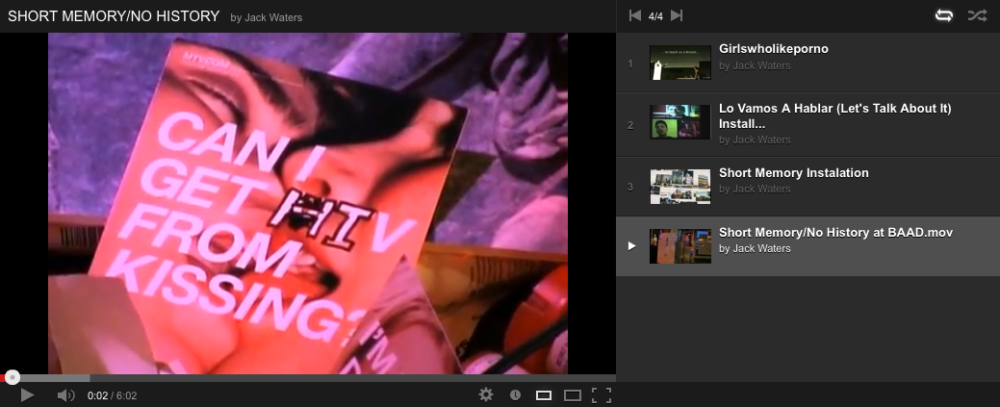The following statement was written by artists Peter Cramer and Jack Waters for the (re)Presenting AIDS public forum on culture and accountability hosted by Visual AIDS, the Pop Up Museum of Queer History, and the Center for Lesbian and Gay Studies at CUNY on August 20th. Cramer and Waters were unable to attend. It was read by activist Stephan Georgiou.
Tuesday, August 20, 2013
Statement by Peter Cramer and Jack Waters
We first want to thank Hugh Ryan of the Queer POP UP Museum and Ted Kerr of Visual AIDS for assembling this distinguished panel and Stephan Georgiou for representing us here today.
Our experience in creating presentations on this subject has been with cultural institutions like Bronx Academy of Arts and Dance (BAAD), the Shedhalle in Zurich, Switzerland, and most significantly for the Center for Contemporary Culture of Barcelona (CCCB) in 2005.
Our curation titled "Lo Vamos a Hablar (Let's Talk About It) was the first time that the CCCB had ever observed World AIDS Day. While it seemed odd to us to be asked as foreigners to represent such an auspicious event, we’ve had a long history in Barcelona and welcomed the chance to further expand our ongoing multi-platform work in process, “Short Memory /No History: A Case of Cultural Amnesia” that was first installed at Shedhalle in 2000.
SM/NH is a living archive of an art practice that intersects with AIDS, Art and Activism. Our approach at CCCB was to give a perspective on how AIDS affected New York City’s Latino community, and how that community responded to the epidemic. As a site specific variable media project "Lo Vamos a Hablar" presented conditions that we feel are essential in addressing AIDS themed exhibitions.
First there must be adequate resources to meet the requirements of presenting the material if it is to be relevant to both curators and audiences alike. The support we received from CCCB was enough to commit ourselves as HIV positive people who feel an absolute necessity to relate our version and vision as an example of an expansive story.
Secondly, there must be direct community involvement from wherever the show happens. This means that outreach must be made not just to artists and arts organizations, but to social workers that deal with the subject on a daily basis and know firsthand the situation of not only the disease, but the social and economic disparities of healthcare,housing and education. In the case of the CCCB installation we were New Yorkers who had been to Barcelona many times over the course of 20 years for reasons as disparate as our first European dance tour and later as spectators at the 1990 Summer Olympics. Prior to our mounting "Lo Vamos a Hablar" we’d met local artists, activists and anarchists from the Queer anarchist gathering known as Queeruption in Barcelona. We knew from our social and political engagement with them that they were affected and involved in the subject of AIDS. We asked them to present their works and performances in an institution that they would normally not have had a relationship with - seeing it as out of touch, conservative and part of as system that they opposed. From the institutional perspective of the CCCB the Queer anarchists were marginal troublemakers. Our agenda was to use our position as outsiders as a means bring these disparate factions together. We were told that the initial conflict between the queer anarchists and the staff of the CCCB was assuaged over time as a result of the events and conversations we initiated. Not only were we successful in bridging this cultural divide, we were able to facilitate the institution’s PAYING the activists for their involvement.
The third condition is that there must be a relevance as it pertains to the subject without pandering; to not pose as an authority on the subject In fact,we view our projects as opportunities for our own continuing inquiry. We used the CCCB as an opportunity to relate SM/NH to a trans continental Latino Diaspora. We learned the relationships, commonalities, and distinctions of how the epidemic affected the various Spanish speaking communities of Europe and the Americas by interviewing latinos that were involved in the responses to the AIDS epidemic in New York, Brazil and Spain. We developed a further understanding of what we know as Spain as a nation of diverse, and often oppositional cultures, in the case of Barcelona being the center of Catalonia where radicalisim and anarchy informed the cultural resistance to Castilian oppression under the Franco regime. This presented the detail of translating the written texts and spoken presentations we made during the course of the performances and public forums we presented into Catalan as well as Castilian, in addition to prioritizing the curation of our film and video programming in Catalan, and creating Spanish subtitles for the English spoken documentary we created that has been the centerpiece of the SM/NH project. Importantly we brought Carlo Quispe with us because 1: his Spanish language fluency was essential for communicating with various contacts. 2: his Latino status as a Queer Peruvian American drove home the point of diaspora, and 3: his youth and curiosity brought an objective perspective to the historical nature of the project while appending a present tense context to the epidemic as we currently experience it.
Fourth is that any effort to address the AIDS crisis needs to be a hard, knotty refusal to overcome the social stigma of a disease branded as affecting a marginal portion of the population. Homophobia is endemic in institutions and funders but there are allies that help to move the realities of our LGBT lives to the foreground. The fact that the LGBT community has made a considerable impact in the conversation is a statement that we will not be ignored or silenced.
The project spanned a week of performances and screenings. We collected fliers, brochures, announcements, posters and other literature spanning the heyday of NYC activism to present day activities in Barcelona. The subjects ranging from AIDS/HIV services, drug trial information, treatment options, lobbying actions and demonstrations were displayed and distributed in the gallery and at the events we presented. The topics from our local interviews, public demonstrations, private conversations and dialogues we both instigated and participated in were channeled into the panels and performances we organized.
Our audiences and participants ranged from local AIDS activists; mainly gay men in their 40s and 50s, some of whom were directly influenced by their New York Latino counterparts and others whose experience was their own involvement in the AIDS community of Barcelona. Most of the women we encountered were of the younger generation of queer anarchist activists we invited to participate integrally in the event, with the exception to this being a middle aged woman who spoke at one of the panels about an architectural memorial project she’d designed.
Ultimately any effective presentation must include people with AIDS. We as PWA's must assume responsibilities and actions to guarantee our voices will be heard. All too often history is left to be written by another generation not directly involved- in this case one still aware of the ongoing effects of the disease. Together we must confront the subject directly and humanely in language that delves into the failures and triumphs of our collective experience.
Thank you,
Peter Cramer & Jack Waters
For further insights to our projects please visit the following VIDEO CLIPS:
Montage of media shown at CCCB presented as a multi screen display at MIX NYC
Original production of the material at Shedhalle, Zurich Switzerland

